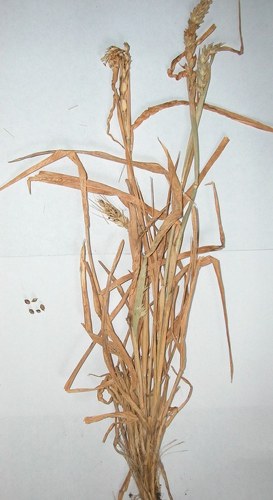Diseases
Tilletia controversa Kuhn - Dwarf bunt.
Systematic position.
Class Basidiomycetes, subclass Teliobasidiomycetidae (=Sclerobasidiomycetidae), order Ustilaginales, family Tilletiaceae, genus Tilletia.Dwarf bunt is a winter wheat disease caused by the fungus Tilletia controversa. Synonims: T. nanifica (Wagn.) Savul., T. tritici-repentis (DC) Liro.
Biological group.
Obligate wheat pathogen.Morphology and biology.
Disease symptoms are apparent upon wheat earing. Infected wheat plants have an increased number of tillers, being stunted, 1.5 to 4 times shorter than healthy plants. Smutted wheat heads are wider and shorter than normal ones, sometimes wrapped in flag leaf until maturity. The awns of bearded wheat are reduced. Spikelets spread, and the number of ovaries in each one is increased. Infected plants produce heads that contain bunt balls with teliospores in place of seeds. At harvest, the smut balls release teliospores that fall to the soil or remain on seeds. They can survive in the soil for as long as 10 years if the smut balls remain intact. Teliospores germinate on soil surface after they mature and only after exposure to low temperatures and diffuse light over a period of 30 to 50 days. Wheat infection appears at soil surface as the developing tillers (shoot infection) and lasts until booting stage. Then, the mycelium grows with the apical meristem during the seedling elongates and the pathogen completes its life cycle by growing into ovaries. The mycelium then splits off into dark thick-walled fragments that develop into bunt balls and teliospores. The bunt balls are distinctly spherical in dwarf bunt. Teliospores are spherical, 19 to 27 microns in diameter and have deep reticulation. Teliospores are covered with a gelatinous sheath 1.5 to 4 microns thick. Teliospores are dark-brown, often black, sometimes (to 8%) hyaline, with smooth or rough surface and reach 17-23 x 12-22 microns in size.Distribution.
Dwarf bunt occurs in many countries of America and Europe. In 1911 the disease was first found in the Ukraine. Later dwarf bunt was registered in Armenia, Ukraine, Kazakhstan, Chechnya and Ingushetia Republics, Azerbaijan, Kyrgyzstan, Turkmenistan, Moldova, Stavropol Territory, and North Osetia. The disease occurs in the foothill regions where wheat is grown (Zakharova (1971), Mutalieva & Ilukhin (1973), Karatygin (1986), Koshelyaeva & Dotsenko (1991), Skripka (1998), Manukyan (2003)).Ecology.
Prolonged periods of scattered light accompanied with temperatures ranging from 3 to 5.C over 3 to 5 weeks, aeration, and soil humidity from 15 to 60% are necessary for spore germination. The favorable temperatures for plant inoculation (0-8.C, maximum 10-12.C) arise under a stable blanket of snow. Temperatures higher than 15.C decrease spore germination.Economic significance.
T. controversa attacks winter wheat; the disease is not registered on spring wheat. Pathogen also occurs on many other cereal species. Dwarf bunt is very harmful. The disease affects yield directly by preventing kernel formation. Its control includes the planting of resistant varieties and healthy wheat seeds, high levels of agriculture, crop rotation, and fungicide seed treatment.Reference citations:
Karatygin I.V. 1986. Agents of cereal smut. Leningrad: Nauka. 112 pp. (In Russian)Koshelyaeva I.P., Dotsenko A.S. 1991. Wheat dwarf bunt on wheat in Kirghizia and protection measures. Scientific works of Kyrgyzstan science-industrial farming agriculture association: Intensification of agriculture in Kyrgyszstan. Bishkek. V. 28: 127-137. (In Russian)
Manukyan I.R. 2003. Phytopathogens of winter wheat in North Osetia. Zashchita rastenii i karantin, 1: 32-33. (In Russian)
Mutalieva K., Ilukhin G. 1973. Dwarf bunt and protection measures. Vestnik selskokhozyaistvennoi nauki Kazakhstana, Alma-Ata, 4: 26-29. (In Russian)
Skripka O.V. 1998. Dwarf bunt on wheat. Zashchita rastenii i karantin, 6: 36-37. (In Russian)
Zakharova T.I. 1971. Dwarf bunt on wheat. In: Methods of territory long time plant diseases prediction. Leningrad: VASKNIL, VIZR. 92 pp. (In Russian)
© Gultyaeva E.I.


